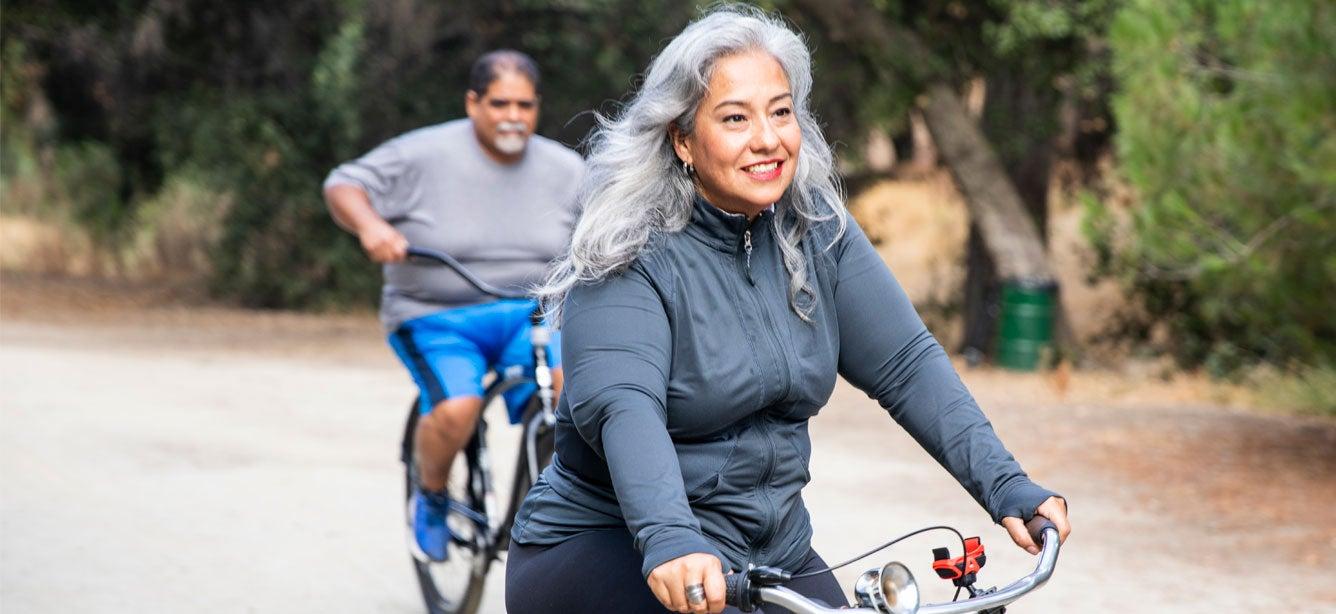
Related Topics
Obesity is a word most of us are familiar with, and it’s often associated with powerful perceptions and emotions. But what does it actually mean to be living with obesity? How does this condition impact a person’s health and life—and how can older adults manage their weight to promote healthy living?
According to the Obesity Medicine Association, obesity is “a medical disease that occurs when a person’s body accumulates and stores excessive amounts of body fat.” The Centers for Disease Control and Prevention (CDC) groups weight into four different categories: underweight, normal, overweight, or obese. People who fall into the latter group have a body mass index (BMI) of 30 kg/m2 or greater. Obesity is not the same thing as being overweight, which is defined as having a BMI of 25 kg/m2 to <30 kg/m2.
BMI is a general measurement, but it doesn’t take into account a person’s body composition or how much fat and muscle they have. Overall health and lifestyle factors may be more important than BMI in older adults.
How many Americans live with obesity?
Over the past few decades, obesity has become an epidemic in the United States. From August 2021 to August 2023, the age-adjusted U.S. obesity rate in adults was 40.3%.1 This condition costs the US health care system nearly $173 billion a year.2
While obesity in America affects all populations, it appears to impact some groups more than others. Severe excess weight has also been linked with income level and socioeconomic status.
What is the stigma surrounding obesity?
Even as America grows more awary of diet culture and promotes body positivity messages, obesity is still often viewed as a behavioral problem. People who carry significant extra weight may be falsely labeled as lazy or lacking self-control. Many deal with bias and discrimination in their personal relationships, during healthcare visits, and even in the workplace.3
The issue of excessive body weight goes much deeper than physical appearance:
- According to CDC, people who carry extra weight are at risk for a number of serious chronic conditions such as heart disease, gallbladder disease, stroke, type 2 diabetes, and certain types of cancer. COVID-19 and obesity have also been linked, since being overweight can increase your risk of complications and severe illness from the virus.
- People living with obesity may also experience quality-of-life issues, chronic pain, mobility issues, and depression or anxiety.
- The loss of lean muscle mass and function (sarcopenia) is also common among older adults with obesity. This is due to metabolic changes related to the aging process; sedentary lifestyles, and acute or chronic disease conditions.4
In 2013, the American Medical Association (AMA) officially recognized obesity as a chronic disease. This was a major step forward in destigmatizing the topic, though there is much more work to do. Classifying obesity as a medical issue empowered both patients and doctors to discuss it more openly and explore treatment interventions.
What causes obesity?
Obesity is thought to be caused by a combination of genetic and behavioral factors. These include:
- Dietary habits
- Physical inactivity
- Family history
- Certain diseases (e.g. Cushing’s disease)
- Some medications (e.g. antidepressants)
Environmental factors may come into play as well. Food deserts are areas where people lack access to affordable, nutritious food.
What are the treatment options for obesity?
The good news is that obesity is a preventable and treatable disease. There is a full range of treatment options to explore, including:
- Lifestyle changes, such as eating more healthfully and incorporating more physical activity into your routine
- Bariatric surgery, which involves procedures that reduce the amount of food the stomach can hold
- Anti-obesity medications (AOMs)
There’s no one-size-fits-all solution for addressing obesity. Instead, the best strategy is to speak with your provider about the different options available and how you can best meet your goals for a healthy weight.
“A registered dietitian nutritionist can help you create a healthy eating plan that’s tailored to your lifestyle and individual needs,” says Gretchen Tanbonliong, Associate Director of Health & Wellness at NCOA and a registered dietitian nutritionist herself.
Managing obesity not only requires working closely with a healthcare provider; it depends on having insurance coverage for all treatment options.
Times are changing, and obesity is slowly but surely gaining acceptance as a serious health condition. If you’re an older adult who is living with excess weight, hope and help are available. You have options that can enable you to reach a healthy weight, reduce your risk of chronic disease, and live a longer, happier life.
Did you know that Americans now have an Obesity Bill of Rights? Find out more at right2obesitycare.org.
Sources
1. Centers for Disease Control and Prevention. Obesity and Severe Obesity Prevalence in Adults: United States, August 2021–August 2023. September 2024. Found on the internet at https://www.cdc.gov/nchs/products/databriefs/db508.htm
2. Centers for Disease Control and Prevention. About Obesity. January 23, 2024. Found on the internet at https://www.cdc.gov/obesity/php/about/index.html
3. Rubino et al. Joint international consensus statement for ending stigma of obesity. Nat Med. April 2020. Found on in the internet at https://pubmed.ncbi.nlm.nih.gov/32127716/
4. Donini et al. Definition and diagnostic criteria for sarcopenic obesity: ESPEN and EASO consensus statement. Obesity Facts. February 2022. Found on the internet at https://www.ncbi.nlm.nih.gov/pmc/articles/PMC9210010/pdf/ofa-0015-0321.pdf



